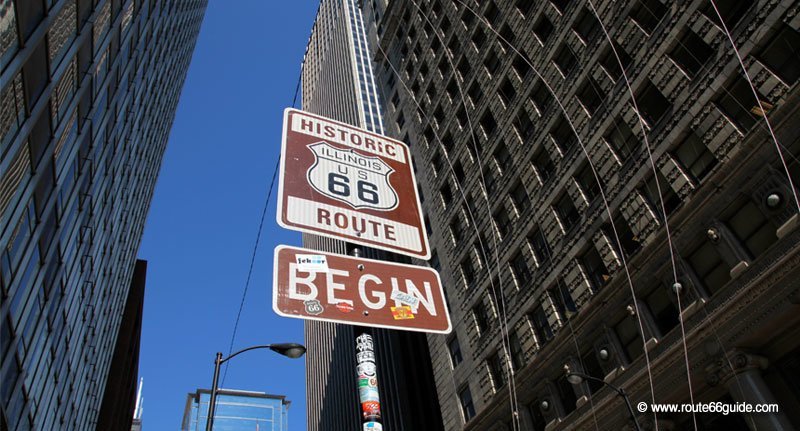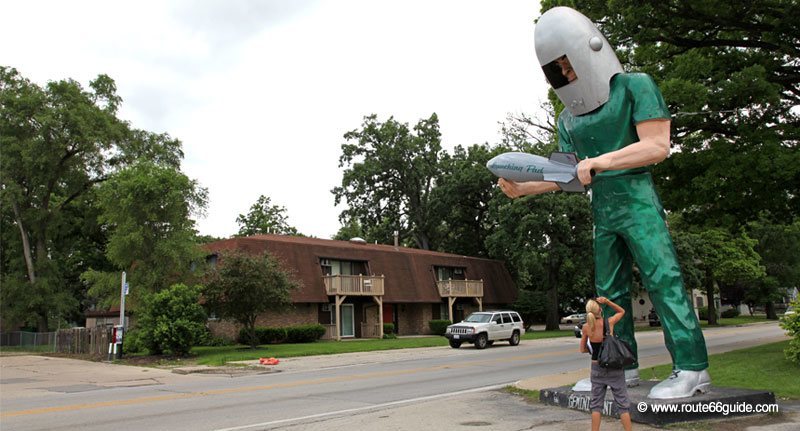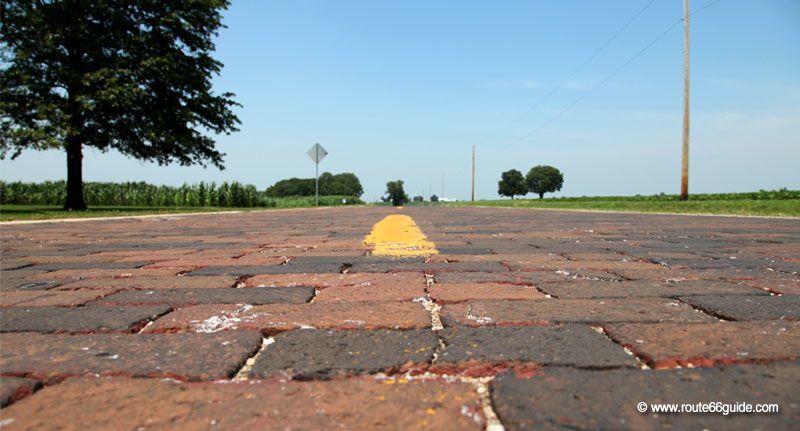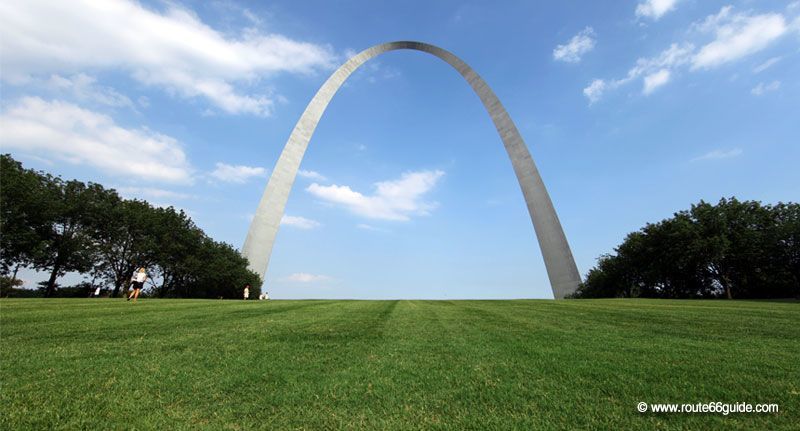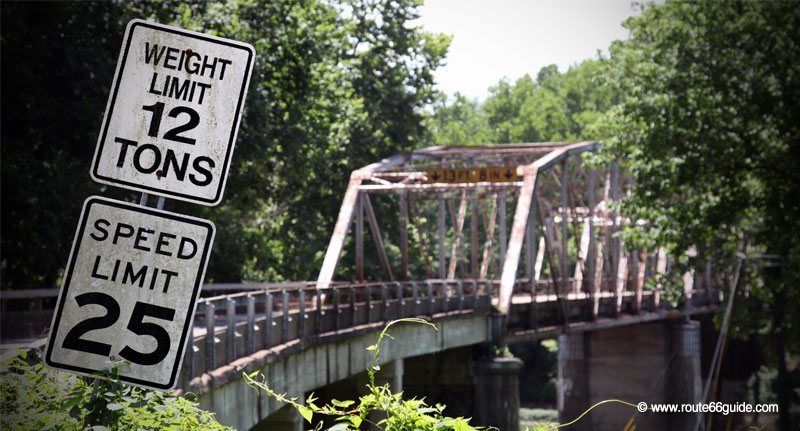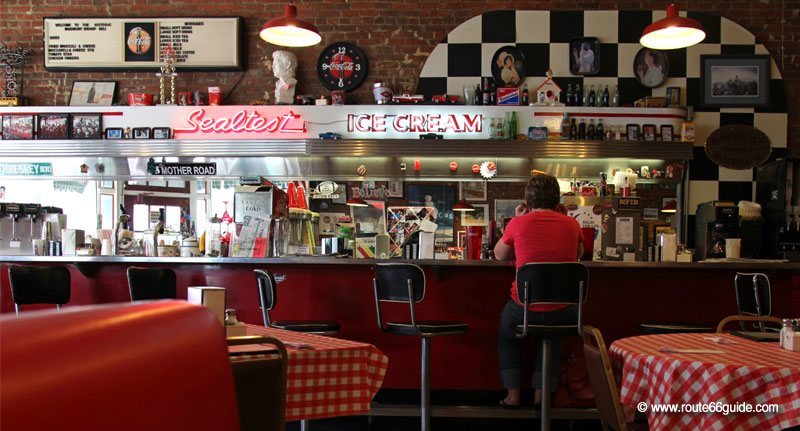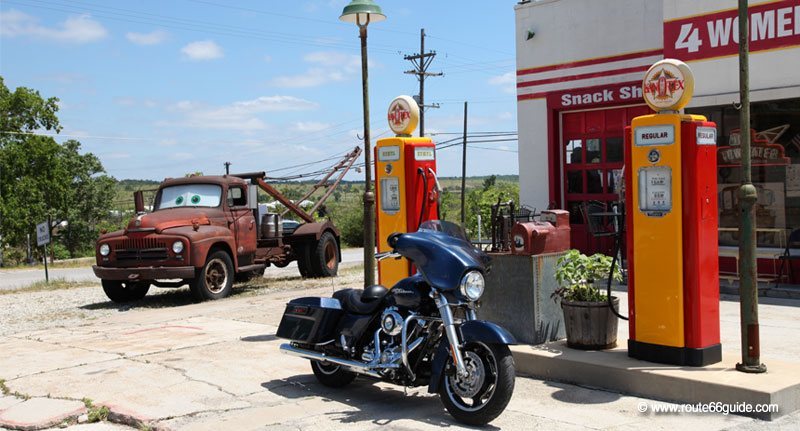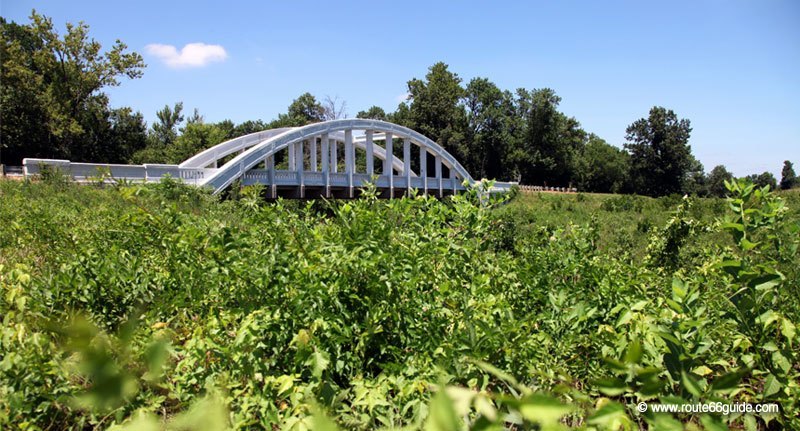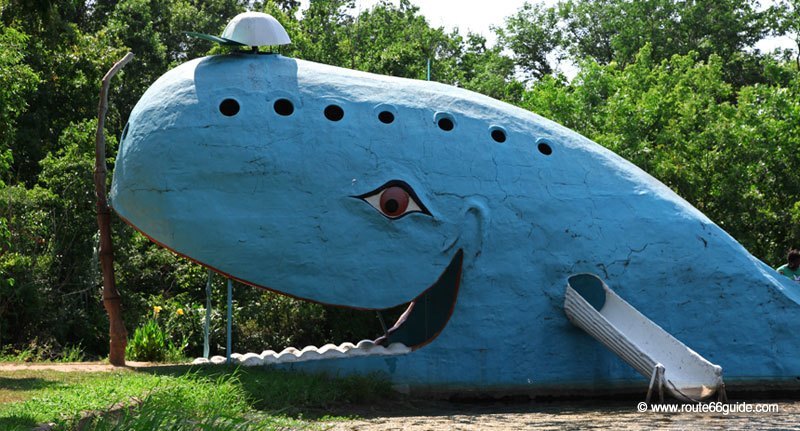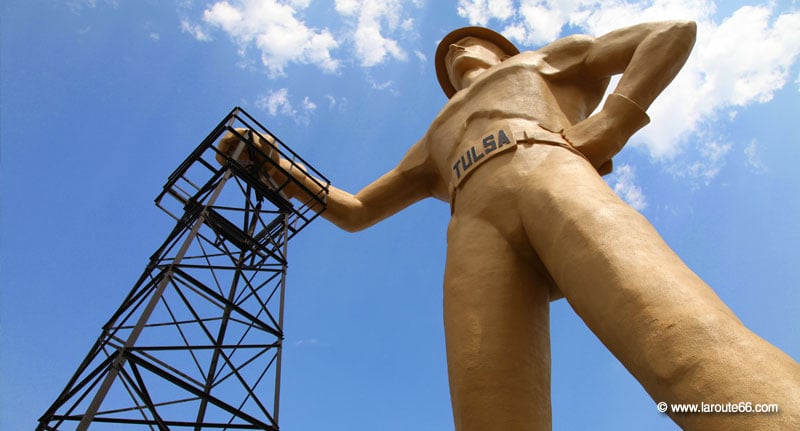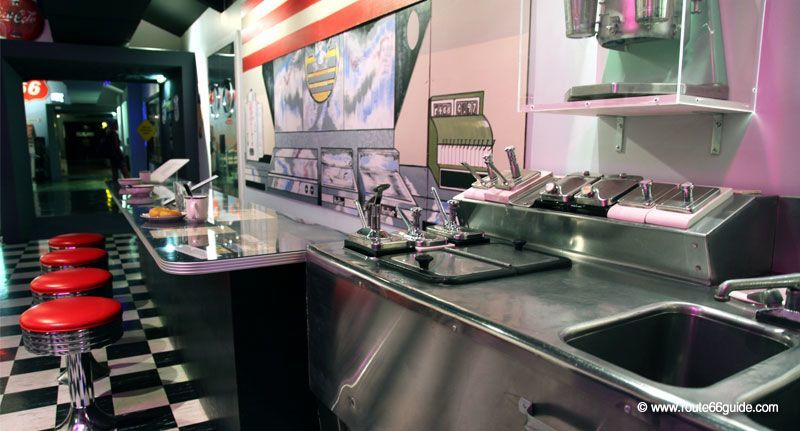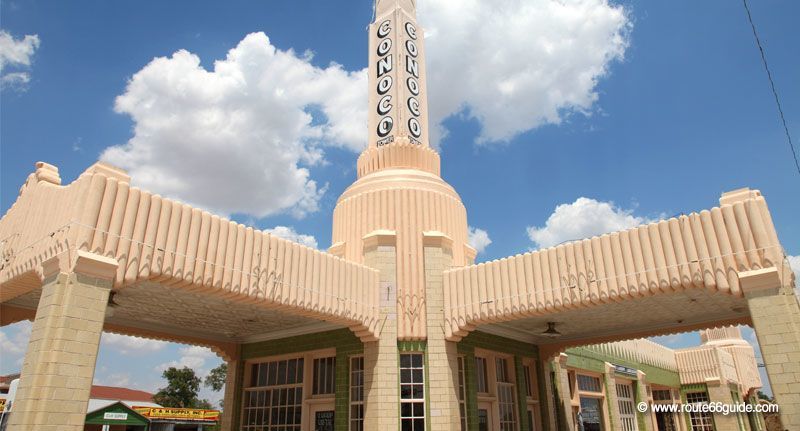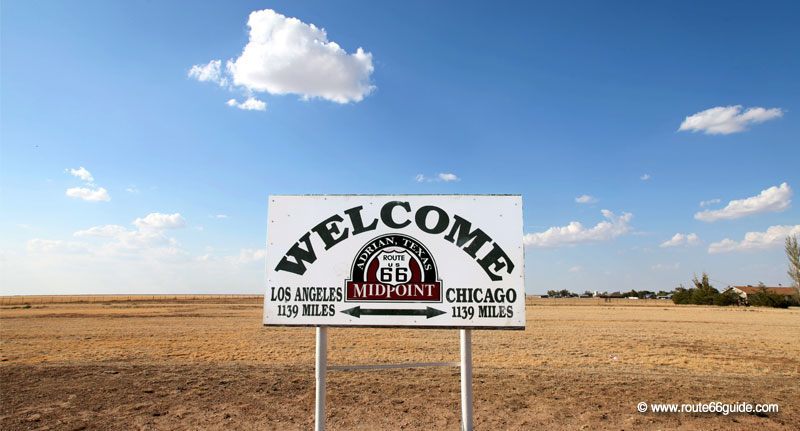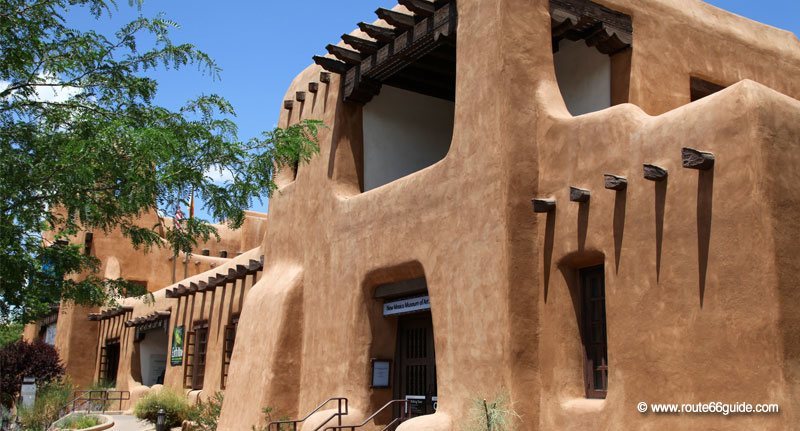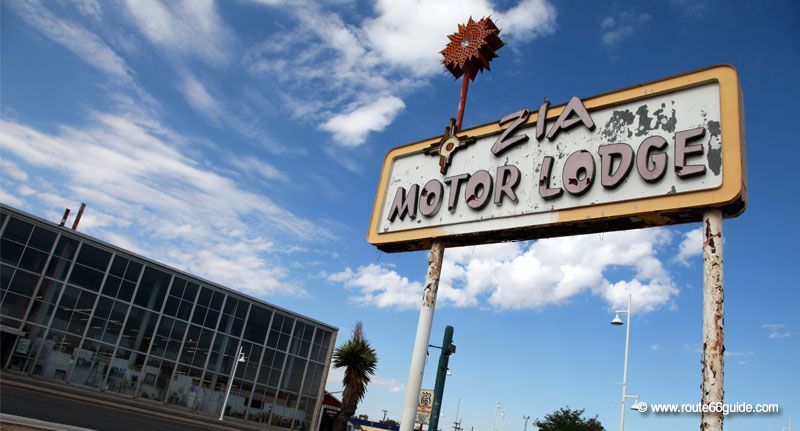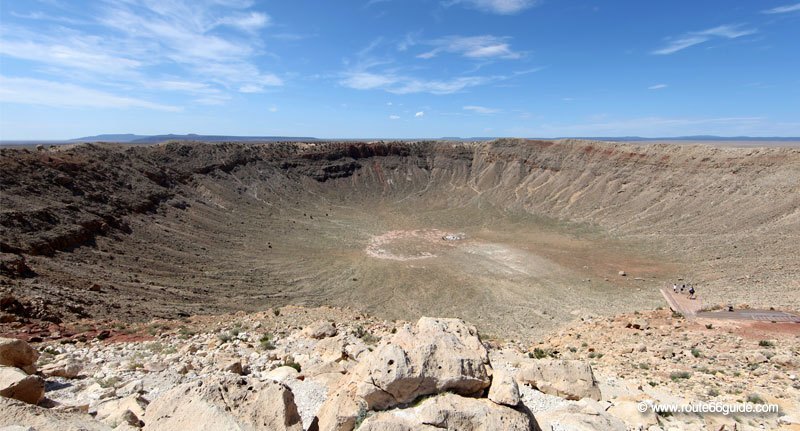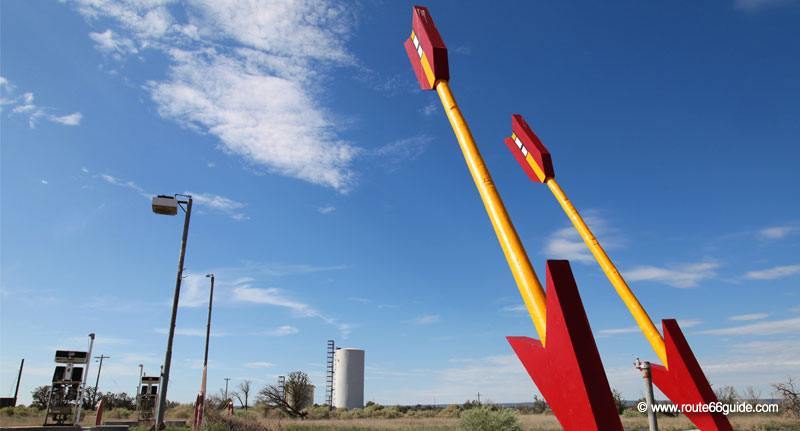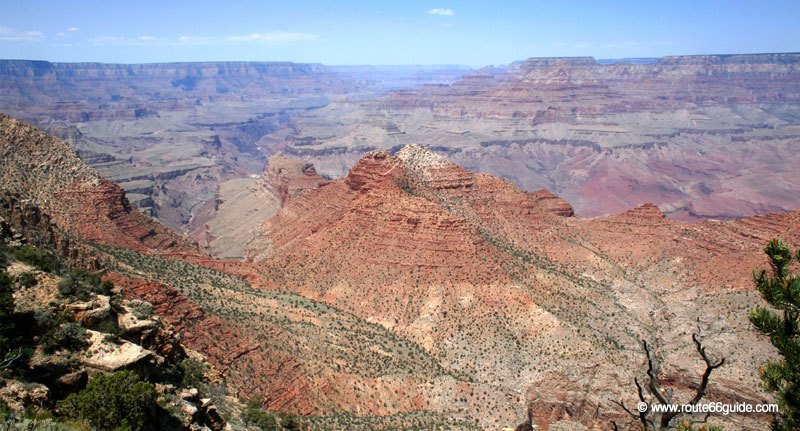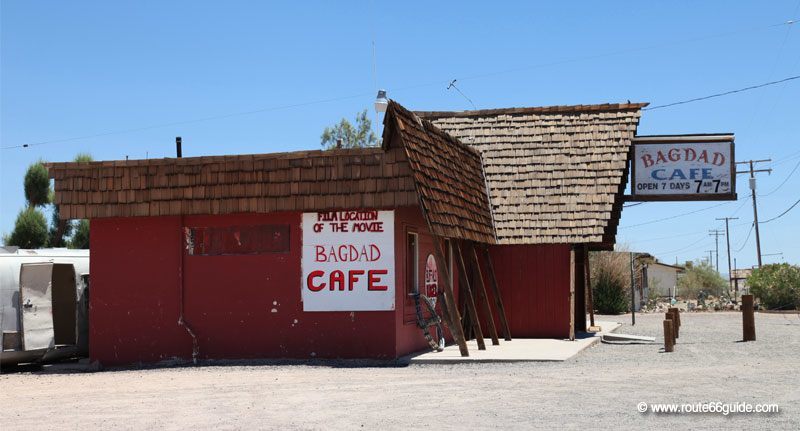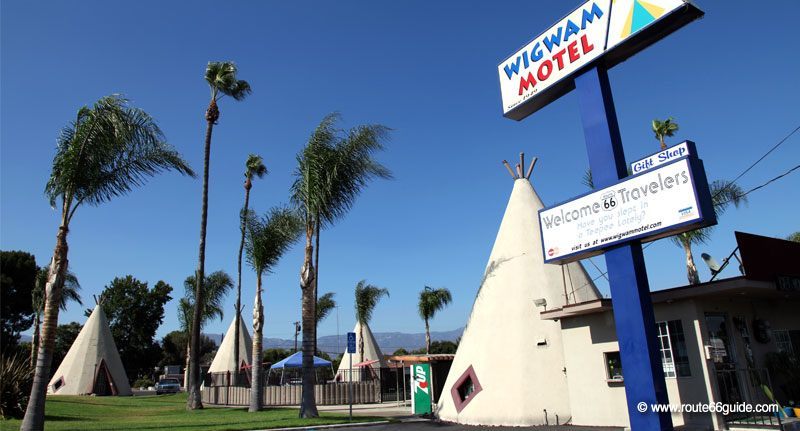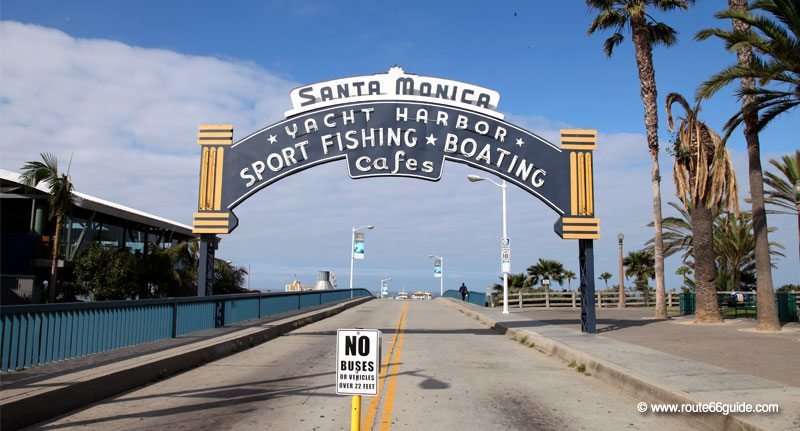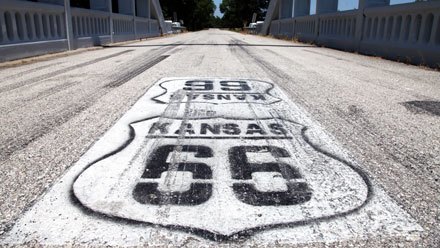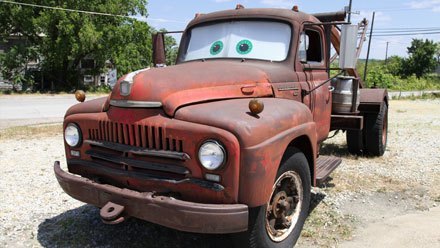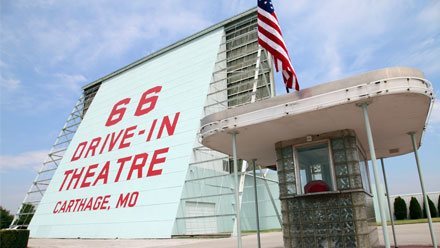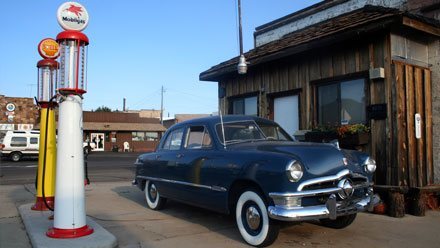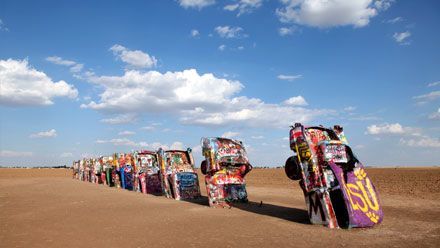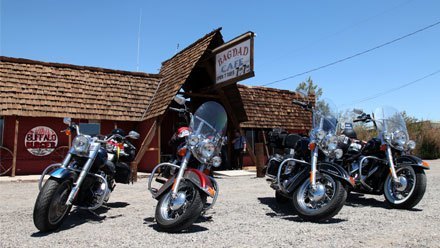Historic Route 66 travel guide
Route 66 in Illinois
Chicago is where it all begins, on the shores of Lake Michigan, in the shadow of some of highest skyscrapers of the continent. Locals claim that, from the top of the John Hancock Center, you can enjoy the most spectacular view of the Windy City's skyline, from the safety of a fully glazed, 360° observatory.
Above: Wilmington, Illinois. The Gemini Giant in front of the Launching Pad restaurant.In the 60s, Route 66 became gradually lined by a multitude of gentle giants such as this, planted in front of shops, restaurants or garages to provide maximum visibility. Children cannot resist this innovative and playful marketing approach. Today, some Muffler men still dominate the road although they are becoming increasingly rare.
Above: Original pavement of Route 66, Auburn, Illinois.On the Route, you can seldom find original sections - such as this one - with a nearly intact red brick surfacing. At Auburn, the "Route 66 Brick Road" is still – though rarely- used.
Route 66 in Missouri
A real icon of St. Louis and the United States, the exquisitely elegant Gateway Arch rises from the banks of the Mississippi in front of the Illinois plains. It is considered the entry gate to the mythical Midwest. After St. Louis, Route 66 runs into the Deep South, where oil wells, cowboys, and the conservative "Bible Belt” await.
Above: Devil's Elbow Bridge, Missouri.Devil's Elbow steel bridge was laid down in 1923 over the Big Piney River. The structure, which can still be crossed by car, appears as a mist-clad ghost early in the morning against the Ozarks isolated forest area. Not surprisingly, it was the scene of several fatal accidents in the heyday of Route 66.
Above: Historic Bradbury Bishop Deli, Webb City, Missouri.In the tradition of Route 66, this historic soda fountain mixes crushed ice and soda for the delight of children ... and of grown-ups too! In the past, these establishments created their own sodas but this tradition is slowly but steadily fading in favor of the ubiquitous fast food chains.
Route 66 in Kansas
Beautifully Restored “Kan-O-Tex" service station. Outside, Mater the tow truck, inspired one of the main characters in the Disney’s animation film "Cars".
Above: Nelson's Old Riverton Store (formerly Eisler Brothers Grocery and Deli), Riverton, Kansas.Undeniably mythical, the small general store in Riverton Kansas has never closed, moving back and forth between grocery store, souvenir shop, and mini-museum on Route 66. The shop hosts the Route 66 Association in Kansas. It was a source of inspiration for Disney's and Pixar's movie "Cars".
Above: Marsh Arch Bridge (Rainbow Bridge), Riverton, Kansas.One of the few standing bridges that once supported the Route 66, beautifully restored by the Route 66 Kansas Association. This is the last one of the three "rainbow" bridges that once stood on Route 66. For safety reasons, it is now closed to traffic.
Route 66 in Oklahoma
In the 1970s, the Blue Whale of Catoosa was almost a mandatory stop for all families traveling on Route 66. Immersed in a beautiful pond adjoined by shaded picnic areas, it was transformed into diving board, waterslide, playground, etc. Today, water languishes but the whale remains and welcomes its visitors inside (swimming is no longer allowed).
Above: The Golden Driller in Tulsa, Oklahoma.Oil has always held a special place in the history of Oklahoma. For a long time, the state was one of the largest oil producers in the country and roads are regularly lined up by oversized monuments honoring the oil industry. Same thing for Tulsa. The Golden Driller sculpture is 76 feet tall, facing the International Petroleum Exhibition.
Above: Oklahoma Route 66 Museum in Clinton.One of the finest museums dedicated to Route 66. It does not simply display photos, objects, press articles on the historic route, but also offers real, amazingly well-crafted reconstructions of some iconic sites of Route 66's heyday: family diner, gas stations, garages, etc.
Route 66 in Texas
The former Conoco gas station and adjacent old motel are among the most beautiful buildings of the late 30s along Route 66. Its emblematic profile, with two towers flanking the long building in pastel shades, inspired Ramones garage in the animation film "Cars."
Above: Cadillac Ranch in Amarillo, Texas.The "Cadillac Ranch" of Stanley Marsh 3, a must-see postcard, directly on Route 66, portrays the evolution of the automobile brand "Cadillac" over the decades. The sculpture consists of 10 models with their nose driven into the Texas desert. Repainted regularly, visitors are allowed to tag them in the spirit of "Public Art", a participatory artistic movement with strong presence along Route 66.
Above: Adrian, Texas. Halfway on Route 66.This sign, planted in the desert on the outskirts of the small town of Adrian, marks the midway position of this small town on Route 66, sitting at 1,139 miles from Chicago and Los Angeles. Such claim to fame is however hard to ascertain, as Route 66's alignments have constantly changed over the decades and the neighboring town also boasts the title of "Midpoint of Route 66".
Route 66 in New Mexico
The town of Santa Fe did not stay long in the vicinity of Route 66. Since 1937, the beautiful city of Spanish inspiration was bypassed as too isolated, in the heart of the Sangre de Cristo Mountains, 2,135 meters above sea level. Santa Fe, founded in 1610, is the oldest city in the West. The municipality, which jealously protects its beautiful adobe buildings and historic city center, is one of the most enjoyable along Route 66.
Above: Zia Motor Lodge sign in Albuquerque, New Mexico.With nearly 30 miles, Central Avenue crosses the entire city and reputedly is the longest avenue in the world. Route 66 follows it east to west through Albuquerque, resulting in an enormous concentration of motels and restaurants - over a hundred in the 50s. Today, just a scattered few survive, grimly announced by ghost giant panels on the longest avenue in the world.
Above: 66 Diner in Albuquerque, New Mexico.This is probably the most beautiful Diner on Route 66. Simply called "66 Diner", its rounded-profile building lies at the center of a large parking lot whose streetlights evoke its past splendor. This iconic architectural style of the 40s, the "streamlined style", was once prevalent on Route 66 although few identical buildings have been so remarkably restored.
Route 66 in Arizona
49,000 years ago, the Arizona desert was hard hit by a meteorite crashing at more than 28,000 mph, destroying all plant and animal life within a 90-mile radius. On impact, the meteorite created a spectacular 4,000 ft. wide and 570 ft. deep crater. The site, accessible for a fee and fitted with viewing platforms, is slightly off Route 66.
Above: Twin Arrows in Arizona.During the 50s, Route 66 welcomes a new generation of "baby boomers" in shorts and invents fun advertising concepts to attract families. While the giant arrows of the former Twin Arrows resort have been restored, the property itself is collapsing.
Above: Grand Canyon National Park near Williams, Arizona.Even if slightly removed from Route 66, the Grand Canyon is nonetheless one of its flagship attractions from its early days. Williams and Flagstaff are the traditional National Park gateways and host the majority of restaurants and hotels around the Grand Canyon.
Route 66 in California
Set for the homonymous film, the coffee is always open along Route 66, isolated in the middle of the Californian desert, a few miles off the small town of Newberry Springs.
Above: The WigWam Motel in Rialto, CaliforniaWith its iconic hard –fabric teepee, the WigWam was once part of a chain of motels scattered along Route 66. Today, only two establishments of the old chain remain, the other located a little further east in Holbrook, Arizona.
Above: Santa Monica Pier, California.After nearly 2,500 miles, Route 66 comes to an end before the world-famous panel of Santa Monica Pier, the platform of the chic little town of Santa Monica, a suburb of Los Angeles on the Pacific Ocean shore.


